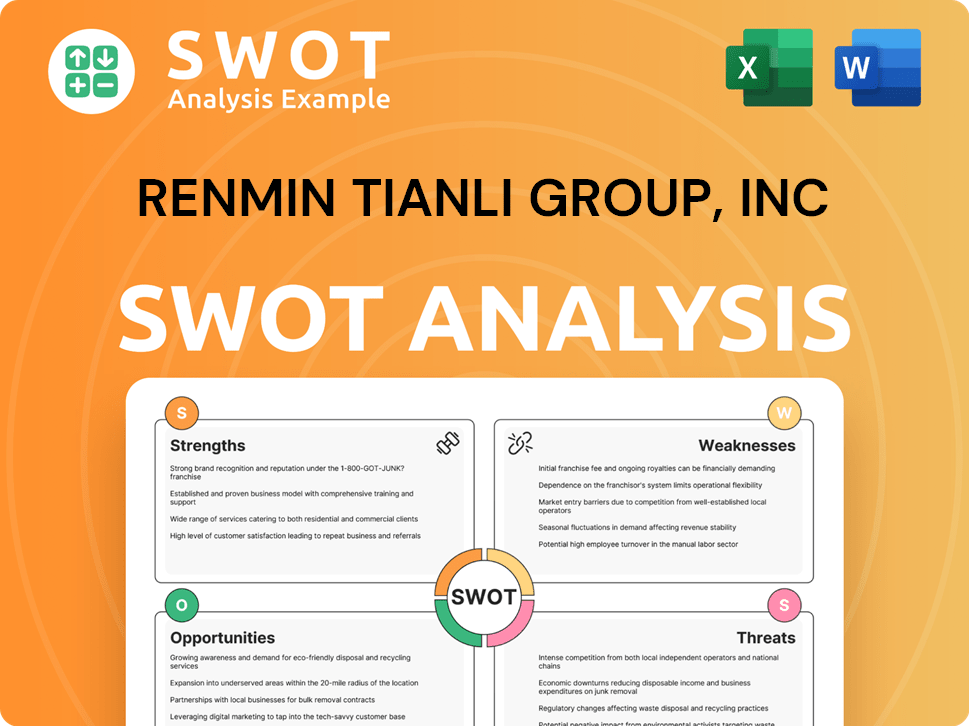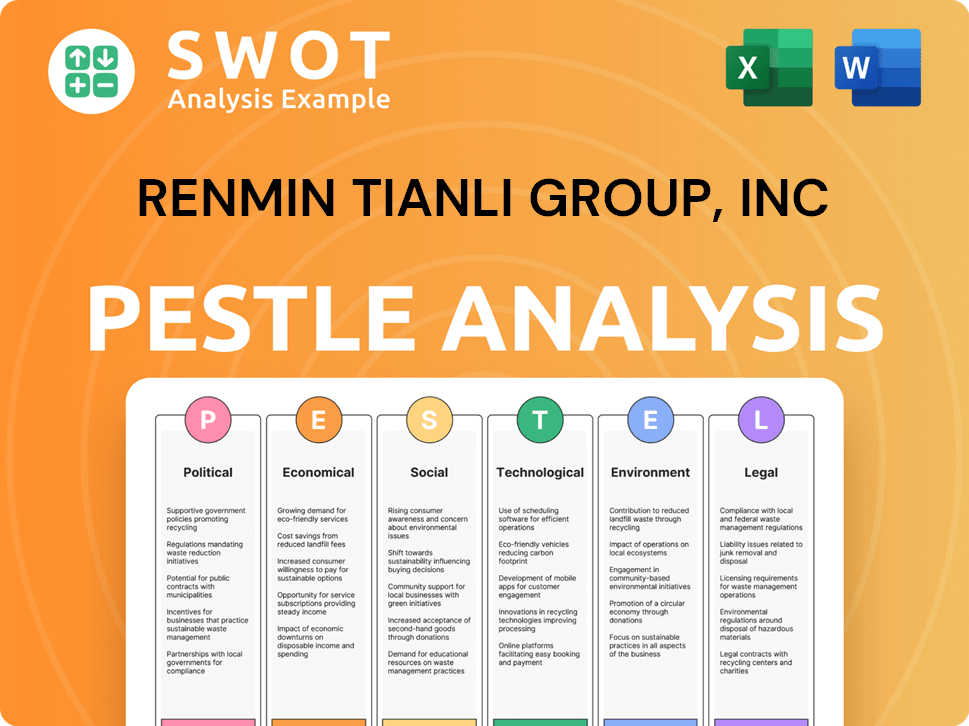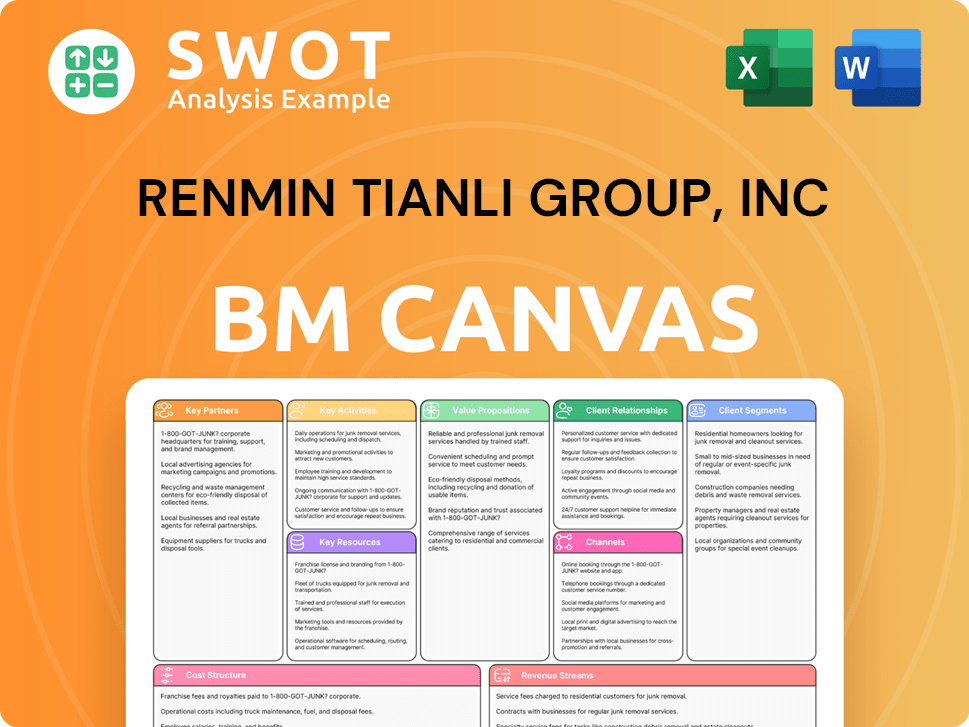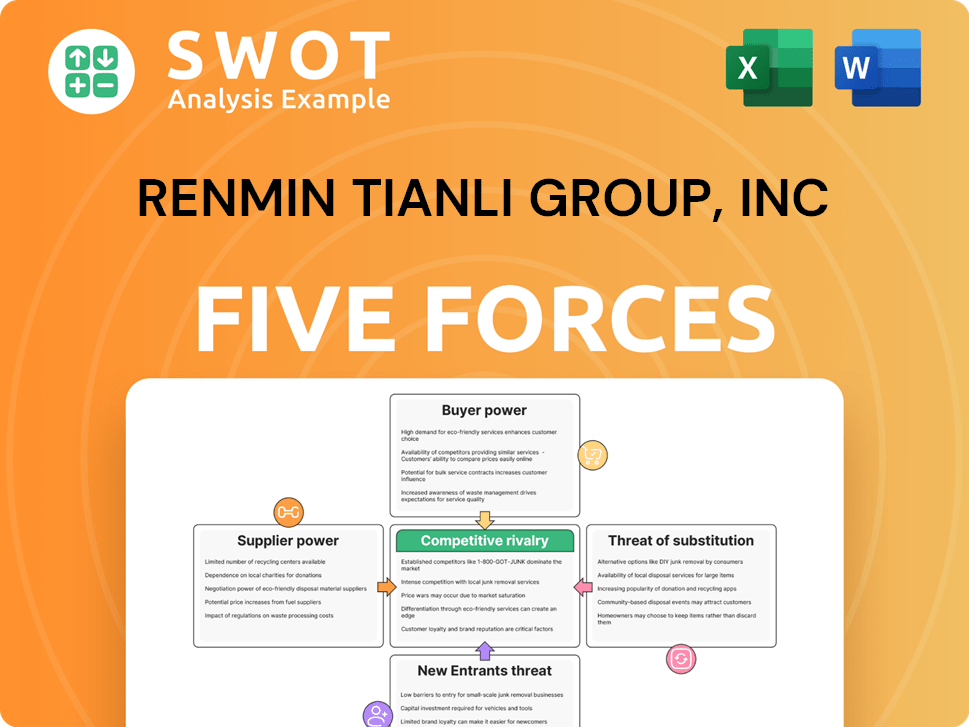Renmin Tianli Group, Inc Bundle
What Defined Renmin Tianli Group Inc's Customer Base?
Delving into the Renmin Tianli Group, Inc SWOT Analysis reveals a fascinating case study in market adaptation. Understanding the company's customer demographics and target market analysis is essential to grasp its strategic shifts. This analysis provides insights into the challenges faced in the Chinese agricultural sector and the importance of adapting to changing consumer preferences.

Despite Renmin Tianli Group Inc ceasing operations, examining its historical customer base offers crucial lessons. The company's initial focus on hog farming and pork sales in Wuhan City provides a foundation for understanding its early market segmentation and consumer profile. This exploration is particularly relevant given the dynamic nature of the Chinese agricultural market and rising consumer demand. Analyzing Renmin Tianli Group's customer needs and adapting strategies provides valuable insights for any business strategy.
Who Are Renmin Tianli Group, Inc’s Main Customers?
Understanding the customer demographics and target market of Renmin Tianli Group, Inc. is crucial for grasping its business strategy. The company's primary focus was within the agricultural sector in China, serving both business-to-business (B2B) and business-to-consumer (B2C) segments. A detailed target market analysis reveals the company's approach to different customer groups and how it adjusted its strategies over time. To understand the customer base, we need to examine the segments it served and the shifts in focus that occurred.
Initially, Renmin Tianli's operations were centered around hog farming. This involved selling young breeder hogs to other hog farmers and brokers, which was a significant part of its revenue. Simultaneously, the company also targeted consumers with its specialty pork products under the 'Xiduhei' brand. The company's ability to adapt and expand its reach through online channels like Taobao.com and WeChat demonstrates its responsiveness to evolving consumer behaviors. This dual approach highlights a strategic understanding of different market segments and customer preferences.
The company's customer base was diverse, with no single customer in the B2B segment accounting for more than 10% of its total or segment revenues as of 2017. This diversification helped mitigate risks. The B2C segment was targeted with premium pork products, suggesting a focus on consumers who valued quality and were willing to pay more for it. The shift towards online sales channels also indicates an understanding of the growing importance of e-commerce in the food industry. For more insights, consider a look at the Marketing Strategy of Renmin Tianli Group, Inc.
The B2B segment primarily included other hog farmers and brokers. These customers purchased young breeder hogs, which were a high-value product. The company's revenue from this segment was substantial due to the premium pricing of breeder hogs. The diversified customer base helped to stabilize revenue streams.
The B2C segment focused on selling specialty pork products under the 'Xiduhei' brand. These products were sold through supermarkets and online platforms. The target consumers were those seeking premium food options. The expansion into online channels, such as Taobao.com, broadened the company's reach.
Renmin Tianli segmented its market based on business type (B2B and B2C) and product type (breeder hogs and specialty pork). This approach allowed the company to tailor its marketing strategies and product offerings. The company's ability to adapt to market changes was key to its success.
Renmin Tianli planned to diversify into real estate and hotel operations. This would have expanded its customer base to include consumers and businesses in the hospitality and property sectors. This strategic shift would have significantly altered its primary customer segments.
While specific demographic data (like age and income) isn't available, the focus on specialty pork products suggests a consumer profile that values premium quality. The use of online channels indicates a customer base comfortable with e-commerce. The B2B segment comprised hog farmers and brokers, highlighting a focus on the agricultural supply chain. The company's strategic moves were influenced by shifts in the broader Chinese agricultural market.
- B2B Customers: Hog farmers and brokers purchasing breeder hogs.
- B2C Customers: Consumers seeking premium pork products, increasingly using online platforms.
- Market Focus: Wuhan City for retail, with expansion to online channels like Taobao.com.
- Strategic Shift: Planned diversification into real estate and hotels to broaden the customer base.
Renmin Tianli Group, Inc SWOT Analysis
- Complete SWOT Breakdown
- Fully Customizable
- Editable in Excel & Word
- Professional Formatting
- Investor-Ready Format

What Do Renmin Tianli Group, Inc’s Customers Want?
Understanding the customer needs and preferences is crucial for Renmin Tianli Group, Inc. This involves analyzing the demands of both its B2B and B2C segments. The company's approach to meeting these needs is reflected in its product offerings and distribution strategies.
For the B2B sector, the focus was on providing high-quality breeder and market hogs. B2C customers, purchasing specialty pork products, likely sought premium and differentiated meat options. The company's expansion into various retail channels aimed to cater to consumer preferences for convenience and accessibility.
The company's ability to adapt to evolving consumer tastes is vital for its success. Changes in consumer preferences for pork compared to other meats can significantly impact revenue and profitability. This highlights the importance of continuous market analysis and product innovation.
The primary need for B2B customers, such as hog farmers and brokers, was access to high-quality breeder and market hogs. This suggests a focus on superior genetics and health to boost productivity and profitability. Customers directly visited the farms and handled their own transportation, indicating a direct transaction model.
Consumers purchasing specialty pork products, like 'Xiduhei,' likely preferred premium, differentiated meat. The company's distribution through supermarkets, retail outlets, and online platforms catered to consumer demand for convenience. This aligns with the rising market trend for premium and healthy agricultural products in China.
Renmin Tianli Group, Inc. established a marketing team for processed black hog products and planned increased distribution spending. This indicates an effort to meet the growing consumer demand for specialty offerings. The focus on 'specialty' products suggests a response to the desire for unique, high-quality food choices.
The rising consumer demand for premium, healthy, and diversified agricultural products in China is a key market trend. Adapting to changing consumer preferences for pork compared to other meats is crucial for revenue and profitability. Understanding customer needs and preferences is vital for tailoring marketing and product features.
Analyzing purchasing behaviors, decision-making criteria, and loyalty factors is essential for understanding customer needs. The company's strategies, such as selling through various retail channels, reflect an effort to meet consumer demand for convenience and accessibility. This approach supports the need for a robust business strategy.
The company's efforts to meet customer needs include selling through multiple channels like supermarkets and online platforms. This demonstrates the company's focus on adapting to changing consumer preferences. This focus is also reflected in the Revenue Streams & Business Model of Renmin Tianli Group, Inc.
To effectively analyze the customer base, consider the following factors:
- Customer Demographics: Understanding age, income levels, and geographic location helps tailor marketing strategies.
- Market Segmentation: Dividing the market into segments based on needs and preferences allows for targeted product offerings.
- Consumer Profile: Creating detailed consumer profiles helps in understanding buying behaviors and decision-making criteria.
- Customer Preferences: Analyzing what customers value in products, such as quality, convenience, and price, is crucial.
- Marketing Strategies: Tailoring marketing efforts to specific demographics ensures effective communication and reach.
Renmin Tianli Group, Inc PESTLE Analysis
- Covers All 6 PESTLE Categories
- No Research Needed – Save Hours of Work
- Built by Experts, Trusted by Consultants
- Instant Download, Ready to Use
- 100% Editable, Fully Customizable

Where does Renmin Tianli Group, Inc operate?
The geographical market presence of Renmin Tianli Group, Inc. (a company that is now delisted) was primarily centered in China. Its main operations, including its principal executive office and hog farms, were located in Wuhan City, Hubei Province. This concentration indicates a strong regional focus within the agricultural sector.
The sale of its 'Xiduhei' specialty pork products was also concentrated in Wuhan City, distributed through various retail channels. While the company utilized online platforms like Taobao.com, Wechat, and Meituan.com for sales, these efforts aimed to broaden its customer base beyond Wuhan, but the physical operations remained localized.
The company's focus on Wuhan City suggests a specific target market analysis strategy. The company's operations were closely tied to this particular region, with its agricultural and retail activities concentrated there. The company's approach to market segmentation and consumer profile was likely influenced by the demographics and consumer behavior in Wuhan.
Renmin Tianli Group's primary market was Wuhan City, Hubei Province, China. This indicates a highly localized target market. The company's operations, including hog farms and retail sales, were concentrated in this area.
The company utilized online platforms like Taobao.com, Wechat, and Meituan.com to expand its reach. This approach aimed to broaden the customer demographics beyond the immediate geographic area. Despite this, the core operations and physical presence remained in Wuhan.
There is no available data regarding Renmin Tianli's market share or brand recognition across different regions. The company's focus was primarily on Wuhan. Further information about the company can be found in this article about Owners & Shareholders of Renmin Tianli Group, Inc.
Given the company's delisting, any recent expansions or strategic withdrawals in terms of geographical presence are not applicable. The company's operational status has ceased, which makes any current market analysis irrelevant.
Renmin Tianli Group, Inc Business Model Canvas
- Complete 9-Block Business Model Canvas
- Effortlessly Communicate Your Business Strategy
- Investor-Ready BMC Format
- 100% Editable and Customizable
- Clear and Structured Layout

How Does Renmin Tianli Group, Inc Win & Keep Customers?
Understanding the customer acquisition and retention strategies of Renmin Tianli Group, Inc. is crucial for a comprehensive target market analysis. The company's approach varied significantly between its business-to-business (B2B) and retail segments. This difference highlights the importance of tailored strategies based on the specific customer demographics and market segments.
For its agricultural operations, specifically hog sales, Renmin Tianli Group, Inc. primarily relied on direct sales to farmers and brokers. This method minimized marketing expenditures for hog sales, focusing instead on building strong relationships and ensuring product quality. This strategy emphasizes a direct, relationship-driven approach to customer acquisition and retention within the agricultural sector.
In contrast, the retail segment, which focused on specialty black hog pork products, employed a marketing team and increased spending on distribution. The company utilized both traditional retail channels, such as supermarkets, and digital platforms like Taobao.com, Wechat, and Meituan.com. This multi-channel approach demonstrates an understanding of evolving consumer preferences and the need for an omnichannel presence to reach its consumer profile.
Renmin Tianli Group, Inc. used different strategies for acquiring customers depending on the business segment. For B2B sales of breeder and market hogs, the company relied on direct sales to farmers and brokers. Retail sales of specialty pork products involved a marketing team and distribution through supermarkets and online platforms.
- Direct Sales (B2B): Focused on building relationships with farmers and brokers.
- Multi-Channel Retail (Retail): Utilized traditional retail and digital platforms like Taobao.com, Wechat, and Meituan.com.
- Online Expansion: The company's move to online platforms in 2016 aimed to combine online and offline sales.
- Marketing Team: A dedicated marketing team was established to promote and distribute retail products.
The primary acquisition method for B2B customers involved direct sales, with a focus on building relationships with farmers and brokers. This approach reduced marketing costs but relied heavily on the quality of the product and the strength of the business relationships. The customer demographics for this segment primarily included agricultural businesses and intermediaries within the pork industry.
Retail customer acquisition involved a multi-channel approach, incorporating both traditional retail outlets and digital platforms. This strategy was designed to reach a broader customer base. The online expansion aimed to cater to changing consumer behavior, which is part of the business strategy. Platforms like Taobao.com, Wechat, and Meituan.com were utilized.
While specific loyalty programs are not mentioned, the emphasis on "specialty" products and online sales suggests an attempt to cater to customer preferences and improve accessibility. The quality of the product and the establishment of strong relationships were crucial for retention in the B2B segment. The company's expansion into real estate and hotels could have shifted the market segmentation.
The shift towards online platforms in 2016 was a strategic move to combine online and offline sales, anticipating strong growth in the retail business. This move highlighted the importance of adapting to evolving consumer purchasing behaviors. This approach provided greater accessibility and convenience for customers. The company was adapting to the changing market conditions.
The emphasis on "specialty" products indicates an effort to cater to specific customer preferences and potentially command a premium price. High product quality was likely a key retention factor, especially in the B2B segment, where repeat business was crucial. The company likely aimed to meet customer needs through their product offerings.
The company's diversification into real estate and hotel operations suggests a potential shift in acquisition and retention strategies. This would have required different marketing channels and customer relationship management approaches. The long-term impact of these strategies on customer loyalty, lifetime value, or churn rate is unavailable. For more context, explore the Competitors Landscape of Renmin Tianli Group, Inc.
Renmin Tianli Group, Inc Porter's Five Forces Analysis
- Covers All 5 Competitive Forces in Detail
- Structured for Consultants, Students, and Founders
- 100% Editable in Microsoft Word & Excel
- Instant Digital Download – Use Immediately
- Compatible with Mac & PC – Fully Unlocked

Related Blogs
- What are Mission Vision & Core Values of Renmin Tianli Group, Inc Company?
- What is Competitive Landscape of Renmin Tianli Group, Inc Company?
- What is Growth Strategy and Future Prospects of Renmin Tianli Group, Inc Company?
- How Does Renmin Tianli Group, Inc Company Work?
- What is Sales and Marketing Strategy of Renmin Tianli Group, Inc Company?
- What is Brief History of Renmin Tianli Group, Inc Company?
- Who Owns Renmin Tianli Group, Inc Company?
Disclaimer
All information, articles, and product details provided on this website are for general informational and educational purposes only. We do not claim any ownership over, nor do we intend to infringe upon, any trademarks, copyrights, logos, brand names, or other intellectual property mentioned or depicted on this site. Such intellectual property remains the property of its respective owners, and any references here are made solely for identification or informational purposes, without implying any affiliation, endorsement, or partnership.
We make no representations or warranties, express or implied, regarding the accuracy, completeness, or suitability of any content or products presented. Nothing on this website should be construed as legal, tax, investment, financial, medical, or other professional advice. In addition, no part of this site—including articles or product references—constitutes a solicitation, recommendation, endorsement, advertisement, or offer to buy or sell any securities, franchises, or other financial instruments, particularly in jurisdictions where such activity would be unlawful.
All content is of a general nature and may not address the specific circumstances of any individual or entity. It is not a substitute for professional advice or services. Any actions you take based on the information provided here are strictly at your own risk. You accept full responsibility for any decisions or outcomes arising from your use of this website and agree to release us from any liability in connection with your use of, or reliance upon, the content or products found herein.